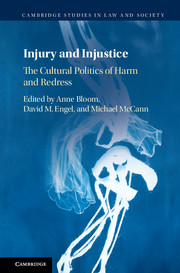Book contents
- Injury and Injustice
- Cambridge Studies in Law and Society
- Injury and Injustice
- Copyright page
- Contents
- Illustrations
- Contributors
- Acknowledgments
- Introduction
- Part I Injury and the Construction of Legal Subjects
- Part II Constructing Injury and Imagining Remedies
- Part III Inequality and/as Injury
- Chapter Ten Injury Inequality
- Chapter Eleven The Unconscionable Impossibility of Reparations for Slavery; or, Why the Master's Mules Will Never Dismantle the Master's House
- Chapter Twelve Inflicting Legal Injuries
- Chapter Thirteen The State as Victim
- Chapter Fourteen Law's Imperial Amnesia
- Conclusion
- Index
- Cambridge Studies in Law and Society
- References
Chapter Eleven - The Unconscionable Impossibility of Reparations for Slavery; or, Why the Master's Mules Will Never Dismantle the Master's House
from Part III - Inequality and/as Injury
Published online by Cambridge University Press: 24 February 2018
- Injury and Injustice
- Cambridge Studies in Law and Society
- Injury and Injustice
- Copyright page
- Contents
- Illustrations
- Contributors
- Acknowledgments
- Introduction
- Part I Injury and the Construction of Legal Subjects
- Part II Constructing Injury and Imagining Remedies
- Part III Inequality and/as Injury
- Chapter Ten Injury Inequality
- Chapter Eleven The Unconscionable Impossibility of Reparations for Slavery; or, Why the Master's Mules Will Never Dismantle the Master's House
- Chapter Twelve Inflicting Legal Injuries
- Chapter Thirteen The State as Victim
- Chapter Fourteen Law's Imperial Amnesia
- Conclusion
- Index
- Cambridge Studies in Law and Society
- References
Summary
- Type
- Chapter
- Information
- Injury and InjusticeThe Cultural Politics of Harm and Redress, pp. 248 - 266Publisher: Cambridge University PressPrint publication year: 2018
References
- 1
- Cited by



